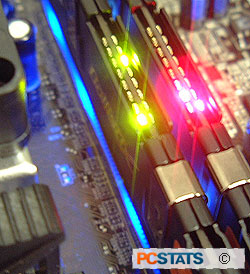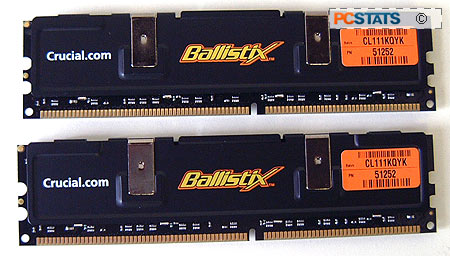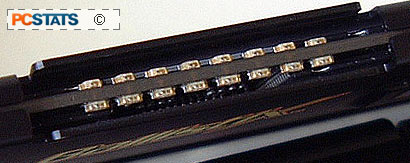Crucial Ballistix Tracer PC4000 Memory Review
As
reviewers, we were extremely pleased to see Crucial
enter the enthusiast memory arena with its Ballistix line of DDR memory. After
all, the entry of a major player like Crucial should help to drive
down prices for the consumer, right?
Variables like speed and CAS
latency are limited by the technology behind each DRAM, so while there have been
concrete innovations here and there, most manufacturers have had to create a
little 'bling, bling' to get their wares out. Once a company has a good
selection of high speed, low latency DRAM to utilize the next issue is building
a high quality 6-layer PCB to mount them on. Aside from a good electrical trace
layout, there isn't all that much more the manufacturer can do to influence
memory performance.  Yet, as we have seen there is plenty a manufacturer can
do to influence how we as consumers show. The most popular way
after heatspreaders is to add lights...
Yet, as we have seen there is plenty a manufacturer can
do to influence how we as consumers show. The most popular way
after heatspreaders is to add lights...
Let's face it, as gamers and case modders, and
general geeks, we are drawn to lights. The brighter the colours, and the faster
they blink the better too. GeIL were probably the first to place LED's onto a
stick of memory, remember the red glowing eyes of the Golden Dragon? Corsair Memory spiced things up even
further with its 'activity LED' enabled PRO-series DDR. With Crucial's Ballistix
Tracer series, the cosmetic upgrades have been bumped to the next level.
Along to top edge
of each stick of the brand-spanking-new Crucial Ballistix Tracer memory are sixteen red & green activity
LED's, and an additional eight blue LED's along the bottom of the DIMM. These
blue underlights are particularly cool as they illuminate each DDR socket.
Each 512MB
Crucial Ballistix Tracer PC4000 stick is rated to run up to 250 MHz,
while maintaining CAS2.5-4-4-8 at 2.8V. The timings are not the tightest, but Crucial is
typically a little conservative so we're hoping for some magic. The Ballistix Tracer memory is also certified to run in both single and dual channel operation, for those wondering.
 |
|
Crucial Ballistix Tracer PC4000 |
|
|
 | |
At first glance the memory looks pretty much like every other DDR DIMM on the market,
but upon closer inspection we can clearly see the LED's on top and
near the pins. The ones on the bottom glow a nice blue on both sides, the
LEDs on the top alternate red and green in colour.
Much like Corsair's PRO DDR memory, Crucial's
Ballistix Tracer DDR indicates memory activity through its assortment of red and green LEDs.
The busier each stick of Tracer DDR is, the faster the LED's
blink and flash. When there's little to no activity, the LED's only cycle
slowly.
 According to Crucial, the brightness
of the LED's on the Ballistix Tracer memory will even vary depending
on how much voltage is pushed through the memory modules (no more than
3V!).
According to Crucial, the brightness
of the LED's on the Ballistix Tracer memory will even vary depending
on how much voltage is pushed through the memory modules (no more than
3V!).
Of course the LED's have absolutely no affect on
system performance, and the lights don't draw any more power than with traditional Ballistix
memory.
PCStats Test Methodology
PCstats tests DDR memory
on two major CPU platforms - the AMD Athlon64 and the Intel Pentium 4 - because
RAM behaves differently with each processor architecture. For instance, Intel
users tend to run their memory at high speeds with high latency settings, and in
general that works quite well for Intel-based computers. It would be detrimental
to system performance if you were to run the same DDR memory settings on an AMD
Athlon64 system, since latency plays a much larger role in system performance.
Because much of our audience is made up
of enthusiasts, PCstats also runs overclocking tests so you can get an idea on
how far the memory will go.
On both
Intel and AMD test PCs, we're only interested in seeing how
high we can go with the memory running 1:1, as running with other dividers puts
the overclocking bottleneck elsewhere, and not with the system memory. On the
Pentium 4 test system we sometimes use higher latencies in our tests, as latencies
are not as important. With the AMD Athlon64 test system, the DDR RAM latency
must run at 2-2-2-5, or the memory's tightest possible timings, as quick access
is more important to the CPU design. So, let's get started!

